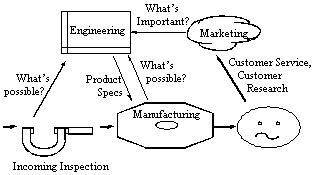

Many manufacturers can reduce manufacturing costs and customer
satisfaction problems by improving the procedures used to set
specifications. Instead, they spend more than required for material
and components, or they have substantial problems in production
due to parts that don't work together as designed. They may also
have customer satisfaction problems with reduced functionality
or lifetime of a product. These problems might be substantially
reduced through more appropriate tolerancing.
The word "Tolerance" is defined as the range of allowable
variability, which is the difference between upper and lower specification
limits for a particular product quality characteristic.
Integrated Tolerance Management is defined as a data-driven
system for establishing product and process specifications to
simultaneously increase customer satisfaction, speed time to market,
and reduce costs.
Integrated Tolerance Management requires the collaboration of
all the parts of the organization depicted in the above figure.
Specifications on product and components, typically set by product
design engineers, are chosen to balance the desired with the possible.
Information regarding what is desired typically comes from Marketing.
Data on the possible -- process capability data -- is sometimes
available from Production and Incoming Inspection. For materials
that are not used in current products, Purchasing might help obtain
relevant data from vendors.
Integrated Tolerance Management helps engineers do a better job
of connecting product and component specifications by providing
them with better information about both the desired and the possible.
For manufacturers that use Statistical Process Control, further
improvements can be obtained by specifying limits on the process
average and standard deviation and avoiding tolerancing individual
parts; this practice is called "process tolerancing".
Process Tolerancing
"Process Tolerancing" is defined as setting specification
limits on the process average and standard deviation. Process
tolerancing rests on two basic observations. First, the primary
use of tolerances in most cases is to control processes and through
that to achieve quality. Second, process tolerancing can substantially
simplify the procedures used to tie component to assembly specifications.
Specifications are needed on individual parts in only two
cases: For some products, they may be required for advertising.
In other situations, 100 percent inspection with substantial scrap
or rework may be required to achieve the level of process control
required in manufacturing. These two cases cover only a small
percentage of specifications used in industry. Even in these cases,
it is generally easier to assure quality by managing processes
than by focussing exclusive on whether individual measurements
are within specification limits. In all cases, process management
is improved by asking for what you want, namely by specifying
limits on process bias and standard deviation.
There has been substantial discussion since 1929 about how to
relate specifications on components to specifications on assemblies.
So-called "worst case" tolerancing has been criticized
because the extreme cases it is designed to handle only rarely
occur. An alternative repeatedly recommended since 1929 has been
"root sum of squares statistical tolerancing." However,
we have recently established that "root sum of squares statistical
tolerancing" is extremely non-robust to violations of assumptions.
(For a report on this issue, contact the Center for Quality and Productivity Improvement at
the University of Wisconsin-Madison and ask for Report 159 on
"Five Ways Statistical Tolerancing Can Fail and What to Do
About Them" by Spencer Graves and Soren Bisgaard.) Most of
these problems can be avoided by placing specification limits
on processes instead of (or in addition to) specifications on
individual units. Most of the remaining problems can be avoided
by using the results of properly designed experiments
for tolerancing, as described by Bisgaard, "Designing Experiments
for Tolerancing Assembled Products," Technometrics,
vol. 39, pp. 142-152.
For more information or for consulting assistance with tolerancing,
call (408)294-5779, fax: (408)294-2343, or e-mail: sgraves@prodsyse.com.
Other Productive Systems Engineering programs: Product Development,
Designed Experiments (Design of Experiments,
DoE or DOX), Reliability Experimentation,
Quick Start Total Quality (Total Quality
Control, TQC / Total Quality Management, TQM), Statistical Process Control
(SPC); Fiber Optic Communication/Transmission Systems
(FOCS or FOTS); Control and Monitoring
(RMM); Electronics (Theory & Application);
Production Line Assembly for Technicians
(Assembly).